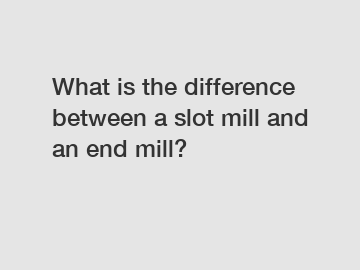What is the difference between a slot mill and an end mill?
In the ever-evolving realm of machining tools, it's crucial to understand the nuances between various instruments to ensure optimal performance. Today, we delve into the realm of milling cutters, focusing on two commonly used tools: slot mills and end mills. Although these tools share similarities, they possess distinct characteristics and are employed for different machining scenarios. In this article, we'll explore the key differences and help you grasp their individual capabilities, enabling you to make informed decisions when selecting the appropriate cutter for your machining needs.
Understanding Slot Mills:
Slot mills, also referred to as slot drills, are power tools primarily used for milling slots or grooves in various materials like metals, plastics, and woods. They comprise a cylindrical shank with multiple cutting teeth set in a spiral pattern around the axis. As the cutter rotates, the teeth efficiently remove material from the workpiece, creating a precisely shaped slot.

One essential feature of slot mills is their constant helix angle, which helps eliminate chatter and ensures smooth cutting. They come in various designs, including two-flute, three-flute, and four-flute, each suitable for specific applications. The number of flutes influences the chip formation process, chip evacuation efficiency, and overall cutting performance.
When to Use Slot Mills:
Slot mills excel at making slots, keyways, and channels with accuracy, making them ideal for tasks such as cutting open grooves for T-shaped joints and dovetail slides. Their robust nature enables them to handle heavy-duty machining, making them suitable for applications that require significant material removal.
Key Differences: End Mills.
End mills, on the other hand, are versatile milling tools designed for contouring, profiling, and generating intricate details on workpieces. Like slot mills, end mills feature cutting teeth positioned on the cylindrical periphery. However, unlike slot mills, they have cutting edges on the end face as well. These end-cutting tools come in various styles, including square-end, ball-end, and corner-radius, catering to specific machining requirements.
End mills are highly adaptable and can be utilized for a multitude of operations, including plunging, ramping, and helical interpolation. They are ideal for tasks like face milling, side milling, and pocketing, allowing users to achieve precise geometries and attain various surface finishes. With end mills, even complex 3D contours can be smoothly crafted, ensuring exceptional design fidelity.
Determining the Best Applications:
End mills shine in scenarios that necessitate intricate contouring and precise profiling. Therefore, when you are working on 3D models, molds, or sculptures that demand aesthetic excellence, end mills should be your tool of choice. Additionally, their versatility makes them valuable assets for general milling tasks, such as creating flat surfaces, chamfers, and radii.
On the other hand, slot mills are unparalleled when it comes to generating slots and keyways or cutting larger channels for structural purposes. Their robust design and specialized configurations allow for aggressive material removal and improved chip evacuation, making them ideal for heavy-duty slotting operations.
Conclusion:
Understanding the critical disparities between slot mills and end mills empowers machinists to optimize their milling processes effectively. While both tools excel in removing material from workpieces, their unique designs and applications differentiate them. Slot mills are adept at slotting tasks and heavy-duty machining, whereas end mills offer versatility and fine detailing capabilities, making them invaluable for complex profiles and 3D-contoured surfaces.
Remember, whether you choose a slot mill or an end mill, it's crucial to select the appropriate tool with the right flute configuration, cutter style, and material-specific considerations. Adhering to these best practices ensures your machining endeavors yield remarkable precision and efficiency.
Investing in the right milling tools might unlock new possibilities and elevate your craftsmanship to unprecedented levels. So, choose wisely, equip yourself with the right knowledge, and embark on a milling journey filled with innovation and remarkable results.
Want more information on Carbide Ball Nose End Mills For Titanium Alloy, ER Sealed collet, ER collets vs TG collets? Feel free to contact us.

Comments
0